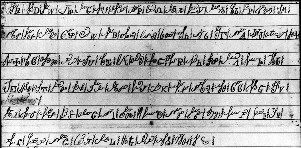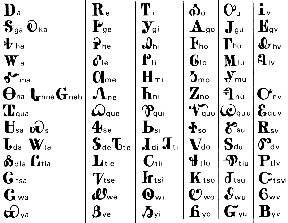| From the John Howard Payne papers
collected at the Thomas Gilcrease Institute of American History and Art
in Tulsa, Oklahoma. The photograph from which the illustration above is
taken is copyrighted by the Gilcrease Museum.
The following pic shows each
letter and its pronunciation.
Sounds Represented by Vowels:
a, as a in father, or short
as a in rival
o, as o in note, approaching
aw in law
e, as a in hate, or short
as e in met
u, as oo in fool, or short
as u in pull
i, as i in pique, or short
as i in pit
v, as u in but, nasalized
Consonant Sounds
h, k, l, m, n, q, s, t,
w, and y as in English.
g nearly as in English,
but approaching k.
Syllables beginning with g
except (ga) can have the consonance of k.
(go), (du), and (dv) are sometimes
sounded: to, tu,
and tv.
Syllables starting with tl [except
(tla)] sometimes
vary to dl.
Letters in parentheses
are sometimes not spoke in everyday language
' indicates accent on
that syllable, following a consonant means the vowel has been left out
? indicates pause after
that syllable
: indicates that the vowel
is long and takes twice as long to say |



